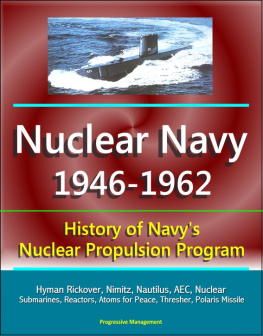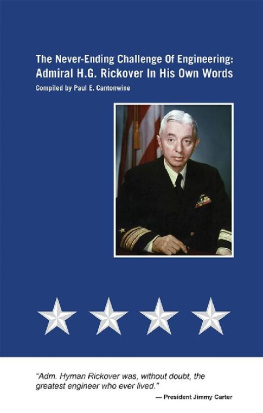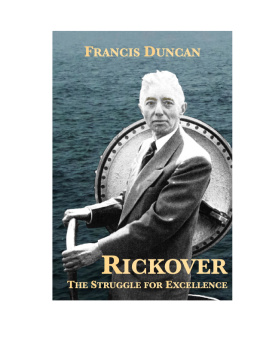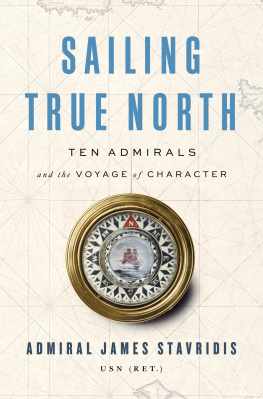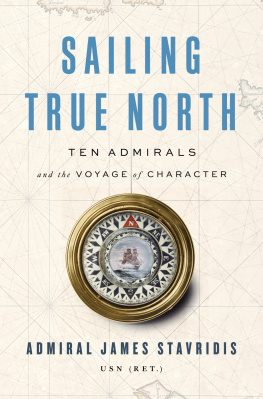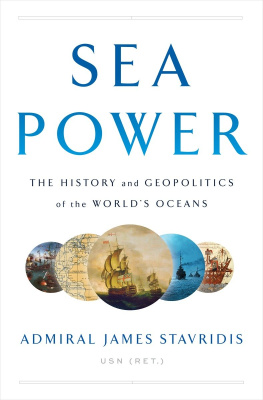ADMIRAL HYMAN RICKOVER

Admiral Hyman Rickover
Engineer of Power

MARC WORTMAN

Jewish Lives is a registered trademark of the Leon D. Black Foundation.
Copyright 2022 by Marc Wortman.
All rights reserved.
This book may not be reproduced, in whole or in part, including illustrations, in any form (beyond that copying permitted by Sections 107 and 108 of the US Copyright Law and except by reviewers for the public press), without written permission from the publishers.
Yale University Press books may be purchased in quantity for educational, business, or promotional use. For information, please e-mail (U.K. office).
Vice Admiral Hyman Rickover aboard the USS Nautilus on June 8, 1958, prior to its transit under the polar ice cap. (Naval History & Heritage Command # 2014.91.01)
Set in Janson Oldstyle type by Tseng Information Systems, Inc. Durham, North Carolina.
Library of Congress Control Number: 2021940519
ISBN 978-0-300-24310-9 (hardcover : alk. paper)
A catalogue record for this book is available from the British Library.
This paper meets the requirements of ANSI/NISO Z 39.48-1992 (Permanence of Paper).
For Jodi You are the solace of my cares, light in the blackest nights, and company in lonely places.
I have long since learned that a man may give offense and yet succeed.
John Adams to Robert R. Livingston, February 26, 1782
CONTENTS
ADMIRAL HYMAN RICKOVER
INTRODUCTION

Something New in the World
I N THE AFTERNOON of May 31, 1953, one of the largest and most daring technology ventures ever attempted was about to reach its culmination. Rising from the high desert flatlands of southeastern Idaho, a six-story concrete and steel blockhouse stood against the distant gray buttes and snow-tipped Rocky Mountains. Inside the National Reactor Testing Station, the Mark I STR, Submarine Thermal Reactor plant, was ready to make steam. When it did, for the first time, nuclear energy would drive an engine. Practical atomic power would be born.
The death-dealing radiance of a thousand suns, as J. Robert Oppenheimer memorialized the atomic bombs, had ended the Second World War less than eight years earlier. The atoms awesome explosive force had etched an indelible nightmare vision on the world. That was about to change. Mark I promised to convert the same energy that incinerated Hiroshima and Nagasaki into controlled machine power.
Inside the Reactor Testing Station, a horizontal, ribbed, steel cylinder lay partially submerged in a forty-foot-high, 385,000-gallon, circular concrete tub of greenish saltwater. About as far from the seacoasts of North America as possible, this land-submarine duplicated the control room, power plant, and propulsion machinery of a real seagoing sub. When the clutch of tense men inside the hull turned the throttle, a chain nuclear reaction would produce enough heat to boil up the steam needed to turn a heavy steel propeller shaft.
In theory.
If successful, a second submarine thermal reactor, the Mark II, based on lessons learned from this prototype, would go into a real United States Navy submarine presently under construction on the Atlantic seaboard. All existing submarines cruised along the surface with noisy diesel engines or, if underwater, on electric power at slow speed for no more than a few hours before they needed to resurface to charge their batteries. However, these boats were easily huntedand often swiftly sunk. But in principle, a nuclear submarine would be able to slide into the depths and maintain top speeds for weeks or even months without need for recharging fuel, air, or battery. Atomic-powered submarines represented a seafaring and naval warfare leap as fundamental as that from sail to steam. This oceangoing sentinel would in theory travel faster and longer underwater than any sub beforealmost unceasingly, like a deep-sea satellite. Nuclear-powered surface ships, even giant aircraft carriers, might follow in the intensifying Cold War with the Soviet Union.
Nuclear reactors were not for warships alone. A new way to generate electricity was also in the offing. The same naval organization that built the Mark I reactor had also begun engineering the first dedicated, commercial-scale atomic power plant, an entirely new utility for electrifying the world. For the first time, humanity would capture the energy encased in an atoms nucleus to power humanitys dreams rather than its nightmares.
If the STR prototype worked, the 13,400-horsepower Mark II would push the twin screws of a submarine being built in Groton, Connecticut. Named Nautilus and designated USSN-571N for nuclearthe sleek and foreboding black and olive-green vessel would surpass its science-fiction namesake that Jules Verne depicted in Twenty Thousand Leagues under the Sea eight decades earlier. President Harry Truman had expressed the wonder of what lay ahead at the Nautiluss keel-laying ceremony the previous year. This ship, he declared, will be something new in the world.... Her engines will not burn oil or coal. The heat in her boilers will be created by the same source that heats the sunenergy released by atomic fission, the breaking apart of the basic matter of the whole universe. Capturing atomic power to drive a ship beneath the waves for previously inconceivable distances was a notion as preposterous as a voyage to the moon.
But it was crazy in another sense as well. An out-of-control nuclear chain reaction would melt the reactor cauldron until it exploded, shooting radioactive steam out across the Idaho countryside, surely killing the men inside the land submarines hull, as well as poisoning the landscape. If it failed, whatever hopes the United States harbored for harnessing the atoms power would be dashed. Given the already widespread skepticisma nice toy, but it will never be practical was a typical refrain heard among the Navy brassthe public backlash to such a catastrophe would put atomic propulsion off the table probably for decades, if not forever.
Inside the land subs maneuvering roomthe power plants operations centermembers of the Nautiluss future crew sat at three side-by-side consoles.watched over their shoulders in the cramped quarters. Standing among them, United States Navy Captain Hyman George Rickover wore civilian clothingper usual. A wisp of a man at barely five and a half feet tall and 125 pounds, Rickovers elongated, slender neck and small, silver-haired head pushed out of his oversized collar like a turtles head from its shell. His sparrows face and piercing hazel eyes bore an almost querulous expression. He spoke in a high-pitched, nasal voice with a twang from the Chicago streets, punctuating his sentences with frequent curses, sometimes directed at the people he spoke to. He never uttered a word of praise.
Rickover was born Chaim Godalia Rykower fifty-three years earlier in the Polish shtetl of Makw-Mazowiecki, then part of tsarist Russia. Past biographers have disputed Rickovers birthdate, contending that he may have altered it to ease his way into the Naval Academy. He did not, but like many central European immigrants, he never knew his true birthdate. He came to believe that he was born on January 27, 1900, the date later inscribed on his gravestone at Arlington National Cemetery. But newly unearthed documents show that he was born a little over a month earlier, December 24, 1899. Six years later, his devoutly Orthodox family came to America to escape antisemitic violence and grinding poverty. With their names Americanized, they eventually settled in Chicago. In 1918, Rickover won an appointment to the United States Naval Academy in Annapolis. Few among his fellow midshipmen liked the little Jew, as one described him. But he survivedhis wordfour years of hazing, marching, antisemitism, and hard study. He held on in a service that tried to shake itself free of him. By now he had already amassed thirty-five years in the Navy.
Next page

